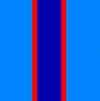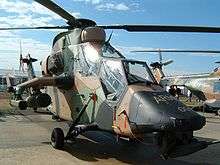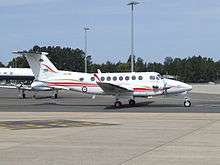Australian Army Aviation
| Australian Army Aviation | |
|---|---|
.gif) | |
| Active | 1960 – Present |
| Country | Australia |
| Allegiance | Australian Army |
| Branch | Australian Regular Army |
| Type | Army aviation |
| Role |
Aerial warfare and |
| Insignia | |
| Badge |
 |
| Roundel |
 |
Australian Army Aviation (AAAvn) is a corps of the Australian Army, and was formed on 1 July 1968 with a strength of 106 officer pilots,[1] although it has a history dating back to 1911, when the Minister of Defence at the time, Senator George Pearce, decided there should be a flying school in the Defence Department.[2] The motto of the Australian Army Aviation corps is Vigilance.
The Aviation Corps utilises soldiers from various other Army corps. The Royal Australian Corps of Transport trains and provides air dispatchers, while the Royal Australian Electrical and Mechanical Engineers trains aircraft structural fitters, who maintain aircraft life support equipment, and avionics technicians. Members of the Aviation Corps are entitled to wear a sky blue beret.
Colours

The design of the colour patch of the Australian Army Aviation Corps is based on the patch of the original Australian Army Flying Corps, from which the Aviation Corps was born. The three Aviation regiments have individual colour patches utilising the Corps patch. 1st Aviation Regiment's patch features a black rectangle in the centre of the Corps patch, 5th Aviation Regiment's patch features a black diamond in the centre, and 6th Aviation Regiment's patch includes a black oval.[3][4]
Equipment
Since November 2009 the Army's air assets are composed exclusively of rotary-wing aircraft (helicopters), the Royal Australian Air Force (RAAF) operating Australian Defence Force's fixed-wing fleet. A limited number of fixed-wing aircraft were used by Aviation Corps, mostly in a surveillance role. A ceremony was held at RAAF Base Townsville on 20 November 2009 to transfer the last three fixed-wing aircraft from the Army to the RAAF.[5]
Rotary-wing aircraft
_NHI_MRH-90_taxiing_at_Wagga_Wagga_Airport_(1).jpg)

The MRH 90 Taipan (Multi Role Helicopter 90, an Australian variant of the NHI NH90). The aircraft are designed for use in a troop-lift role.[6] The first test flight of an MRH-90 was conducted at Eurocopter’s flight test centre in Marignane, France on 28 March 2007. The first 13 of the total of 46 helicopters had been delivered when the remaining aircraft were suspended until issues had been resolved.[7] The first four being built in the main plant in France, the remainder built in Brisbane by Australian Aerospace. The MRH-90 was chosen ahead of the UH-60M Black Hawk.[8] The MRH 90 Taipan is in service with the 5th Aviation Regiment.
The Tiger ARH (Armed Reconnaissance Helicopter) was designed to provide significant reconnaissance and fire support in a combined arms team and is equipped with Hellfire missiles, 70 mm rockets and cannons.[9] 22 Tigers will be delivered to the Army under the AIR 87 Project, built at the Australian Aerospace Brisbane facility. [10] The Tiger ARH achieved Final Operational Capability on 14 April 2016 originally planned for June 2009 and is in service with the 1st Aviation Regiment.[11]
The S70A-9 Black Hawk is operated by the 171st Aviation Squadron and 173rd Aviation Squadron in the 6th Aviation Regiment, and the Army Aviation Training Centre (AAvnTC). Its role is to provide support to Special Operations Command. The Black Hawks were manufactured in Australia by Hawker de Havilland, under licence from Sikorsky. As of 2015, 34 are in service.[12]
The CH-47D Chinook is operated by C Squadron, 5 Aviation Regiment. C Squadron was raised on the Army order of battle in June 1995, on the return of the Chinooks to Australia after re-manufacture by Boeing USA. The Chinooks' primary role is logistic and battlefield support. They can also be used in the troop-lift role. The current fleet of seven CH-47Ds is currently being replaced by 7 new CH-47Fs, the first of which was delivered in May 2015.[13]
The Bell 206B-1 Kiowa has been in service with the Army since 1972; its main roles being observation and rotary flying training.[14] It was also utilised for the command and control of tactical aircraft, such as the F/A-18 and F-111. They often worked closely with artillery and armoured cavalry units. The Kiowa fleet is located in Oakey for use in training at the Army Aviation Training Centre.[15] A portion of the Kiowa fleet are receiving an avionics upgrade and refurbishment (including electronic LCD displays and twin navigation and voice GPS units) during 2010–11. Upgrades to the seating under the Kiowa Energy Attenuating Seat Improvement Program (KEASIP) are ongoing to improve crash worthiness and pilot ergonomics. As of 2009, 27 are in service.[16] The Kiowa will be replaced by the Eurocopter EC135.
The EC135 T2+ (Helicopter Aircrew Training System) is on order to replace the Kiowa for training with a fleet of 15 to be shared with the Navy based at the future Joint Helicopter School at HMAS Albatross.[17][18]
Fixed-wing aircraft

.jpg)
Army Aviation operated fixed-wing aircraft for a period of almost 50 years, from taking delivery of Cessna 180s in 1961 until 20 November 2009. 173rd Surveillance Squadron, based at Oakey, was the last operator of fixed-wing aircraft, using three Beechcraft B300 King Air 350s in Command and Control, Surveillance, and Transport roles. Other aircraft types operated were the Pilatus Porter, the GAF Nomad and the de Havilland Canada DHC-6 Twin Otter.[5][19]
Training
Army pilot
Pilots are very carefully selected and undergo an intense and rigorous training program to produce the best quality officers and pilots for the Australian Army Aviation (AAAvn) Corps.
Selection
Before training can begin, potential pilots must pass a battery of tests to determine their suitability to fly in the realm of military aviation. This includes aptitude testing, a multitude of hand-eye co-ordination tests, psychological evaluation, and numerous medical examinations (including ophthalmological and dental examinations) to maximise the quality and service longevity of selected potential future pilots. Throughout the selection process candidates are continually assessed for their character and suitability as future officers. Afterall, pilots are also officers and must display attributes of responsibility, integrity, professionalism, initiative, leadership, discipline, decisiveness, courage, morality, and loyalty at all times, to both their peers and to the men and women they lead.
Suitable applicants are further scrutinized, and only those elite candidates that display the requisite potential are progressed to the next phase of selection, called the Flight Screening Program (FSP), to deem if they are suitable to fly in the Army as officers. The FSP involves a two-week flying course at the Australian Defence Force's expense and discretion to assess the suitability of the candidate as a potential officer and pilot, in the air environment under conditions of intense flying and instructing. The candidates are also assessed for their officer qualities in addition to their ability to handle their platform in airspace.
Initial Officer Training
Once the candidate has passed the FSP the new recruit is enlisted as an Officer Cadet (rank OCDT) and begins their initial officers' training at the Australian Defence Force Academy before graduating to Royal Military College, Duntroon in Canberra for 12 months of intensive leadership training. Alternatively, a direct entry candidate will begin their training at Royal Military College, Duntroon (RMC-D). At RMC-D the cadet studies subjects such as Army tactics, military customs and ethics, drills, first aid, communication, weapons training, service discipline law, and leadership and management training, to name a few.
This course encompasses:
(i) approximately 6 weeks of training if undertaking the Specialist Service Officer (SSO) pilot scheme,
(ii) approximately 18 months of training if undertaking the General Service Officer (GSO) course as a direct entry cadet, or
(iii) 12 months of training after graduating from the Australian Defence Force Academy, undertaking the General Service Officer (GSO) course
Basic Flight Training
Upon graduating from RMC-D the pilot trainee begins their basic flight training course at the Basic Flying Training School (BFTS) in Tamworth for fixed-wing flight training of approximately 6 months duration on the CT-4B trainer aircraft (PAC CT/4 "parrot"). The BFTS course encompasses both an extensive ground training program (such as airmanship, aerodynamics, aircraft systems, aviation medicine, air power, air traffic control, radio, meteorology, navigation, morse code, instrumentation, and cockpit systems, etc.) as well as an intensive flight training course (including general flying, instrument flying, night flying, navigation, aerobatics, formation flying, and emergency handling). As part of the Basic Flying Training Course, Army pilot trainees complete the Intermediate Pilots Course (IPC) where navigational techniques are taught for Army graduates.
Basic Helicopter Training
Upon graduating from BFTS, students begin Helicopter Qualification Course (HQC) at the Oakey Army Aviation Centre in Oakey, Queensland, of approximately 6 months duration, flying the Bell 206B-1 Kiowa.
Upon completion of HQC, pilot recruits are awarded their provisional Army flying badge ("flying wings") and promoted to the rank of Second Lieutenant if under the SSO scheme. (GSO candidates are promoted to Lieutenant upon graduation from RMC-D).
Operational Helicopter Training
After being awarded their flying wings, pilot trainees move on to their specific type of aircraft for Operational Helicopter Training. Although the type of operational aircraft flown is somewhat influenced by the trainee's preference for a particular aircraft, this decision is primarily at the discretion of the Qualified Flying Instructors (QFI's) that have closely observed the student's temperament, abilities, aptitudes and strong points in airmanship. This decision is also influenced by the needs of the Army, and ultimately the Army's need(s) to fulfil a particular role takes precedence over personal preference or interests.
Training to fly an operational helicopter requires that a student pilot undergo the Operational Type Transition Course (OTTC – of 3 to 4 months duration) and the Regimental Officers' Basic Course (ROBC – of 3 to 6 months duration depending on aircraft type) to effectively transition or convert the new pilot to their new role in the appointed aircraft type. The OTTC consists of up to 50 flying hours of transition training to acquaint the newly appointed pilot to their designated aircraft type. The ROBC consists of 30 to 40 hours of tactical flying (depending on helicopter type) to effectively teach the new pilot to opearte the aircraft in support of Army and ADF units. Upon completion of the ROBC, graduating trainees are promoted to the rank of Lieutenant and are posted to an operational aviation unit.
Aviation Corps trades
There are two specialisations available to soldiers in the Aviation Corps, Groundcrewman Aircraft Support and Groundcrewman Mission Support. Training for both is in addition to 80 days of basic training, undertaken at the Army Recruit Training Centre, Kapooka.
Groundcrewman aircraft support
Basic groundcrewman aircraft support training consists of three individual courses, totalling approximately 19 weeks. The first course conducted is a basic drivers course where soldiers gain qualifications in operating the Army Landrover 110 and Unimog truck. This lasts for 38 days and is held at Puckapunyal in Victoria. The next course to be completed is the two week bulk fuel tanker course held at the Army Logistic Training Centre at Bandiana in Victoria. This course involves instruction in operating bulk and portable refuelling equipment and fuel quality control. The final course, and longest in duration at 9 to 12 weeks is the forward arming and refuelling course, held at the Oakey Army Aviation Centre in Queensland. Here soldiers are taught aircraft refuelling and arming operation both in the barracks and field environment.[20]
After two years as a Groundcrewman, a soldier can request to be transferred to become helicopter aircrew as a "Loadmaster, Crew Chief". Throughout their career, Groundcrewman Aircraft Support also attend the following courses as part of their career development and trade proficiency:
- Fuel Quality Control,
- Explosive Ordnance Supervisor,
- Air Portability Team Leader,
- Destruction of Malfunctioned Explosive Ordnance,
- Workplace Assessor.
Groundcrewman mission support
Training for groundcrewman mission support also consists of three courses, and runs for approximately 15 weeks. The first course, as with groundcrewman aircraft support, is the basic drivers course. The second course is a specialist combat communications course of four weeks duration, held at Oakey Army Aviation Centre. Here soldiers learn to use and maintain service radios, antenna theory and configuration. The second course is the six week command post operator course, also held at the Army Aviation Training Centre.
As with Groundcrewman aircraft support, soldiers employed as groundcrewman mission support may also attend further courses throughout their career. These include a comsec custodian course; an information systems course; an advanced combat communicators course; and a workplace assessor course.[21]
Order of precedence
| Preceded by Royal Australian Infantry Corps |
Australian Army Order of Precedence | Succeeded by Australian Army Intelligence Corps |
See also
- List of Australian Army aircraft
- List of Australian Army aviation units
- Oakey Army Aviation Centre
- Army aviation
- Boeing CH-47 Chinook in Australian service
References
| Wikimedia Commons has media related to Australian Army Aviation. |
- ↑ "History of Australian Army Aviation". Fourays – Australian Army Aviation Association. Archived from the original on August 23, 2006. Retrieved 2007-04-13.
- ↑ "History of Australian Army Aviation". Digger History. Archived from the original on 4 April 2007. Retrieved 2007-04-13.
- ↑ "AFC Imperial Force Army Badge". Australian Flying Corps. Archived from the original on 2007-07-11. Retrieved 2007-05-01.
- ↑ "6th Aviation Regiment". Australian Army. Retrieved 13 July 2013.
- 1 2 Hamilton, Eamon (10 December 2009). "Fixed Wings Freed" (PDF). Army: The Soldiers' Newspaper (1227 ed.). Canberra: Department of Defence. p. 6. ISSN 0729-5685. Retrieved 26 December 2009.
- ↑ Sgt Foxcroft, Sybelle (9 September 2004). "Army looks to Europe for troop-lift carrier". Army: The Soldiers' Newspaper (1105 ed.). Canberra: Department of Defence. p. 1. ISSN 0729-5685.
- ↑ "NH90 TTH operational configuration approved". Australian Aviation Magazine. Retrieved 19 November 2011.
- ↑ "First Australian NH90 Multi role helicopter (MRH90) successfully performed its maiden flight at Eurocopter in Marignane". GlobalSecurity.org. Archived from the original on 14 April 2007. Retrieved 20 April 2007.
- ↑ "Army's Tiger armed reconnaissance helicopters arrive" (Press release). Australian Department of Defence. Archived from the original on 11 December 2007. Retrieved 18 April 2007.
- ↑ "DSTO and Eurocopter sign "Tiger" MOU". Department of Defence. Archived from the original on 11 December 2007. Retrieved 18 April 2007.
- ↑ Beurich, Cpl Sebastian (28 July 2016). "A story of innovation and commitment" (PDF). Army: The Soldiers' Newspaper (1378 ed.). Canberra: Department of Defence. ISSN 0729-5685. Retrieved 31 July 2016.
- ↑ Kerr, Julian (2 December 2015). "Australian Army to extend Black Hawk service lives for special forces use". Jane 's Defence Weekly (53.4). Retrieved 30 July 2016.
- ↑ "Acceptance of two CH-47D Chinook Helicopters". Ministerial press release. Department of Defence. 1 February 2012. Retrieved 2 February 2012.
- ↑ Australian military aviation OrBat
- ↑ "Army aviation in Australia 1970–2015" (PDF). Fact Sheet. Australian Army. 24 February 2015. Archived from the original (PDF) on 8 October 2016. Retrieved 31 July 2016.
- ↑ Ashby-Cliffe, Cpl Jane (12 November 2009). "Kiowas' final salute" (PDF). Army: The Soldiers' Newspaper (1225 ed.). Canberra: Department of Defence. p. 5. ISSN 0729-5685. Retrieved 1 August 2016.
- ↑ "Minister for Defence – New training system for ADF helicopter crews" (Press release). Minister for Defence. 23 October 2014. Retrieved 1 August 2016.
- ↑ McMaugh, Dallas (9 April 2016). "Future ADF training helicopter arrives at HMAS Albatross". Royal Australian Navy. Retrieved 1 August 2016.
- ↑ ADF-serials List of Army aircraft retrieved 26 December 2009.
- ↑ "Careers Explorer: Groundcrewman Aircraft Support". Defence Force Recruitment. Archived from the original on August 25, 2006. Retrieved 2007-04-13.
- ↑ "Careers Explorer: Groundcrewman Mission Support". Defence Force Recruitment. Archived from the original on August 23, 2006. Retrieved 2007-04-13.